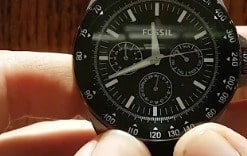The dial on your watch does more than just tell time. It’s actually an intricate part of the watch that tells you what information it can track. Therefore, understanding this component is crucial.

So, what is the dial on a watch? I’ll take you through everything you need to know about the watch dial, including its components and the different types of watch dials available.
What Is the Dial on A Watch?
A Watch dial is the part that contains the hour markers and the watch hands. It’s essentially the part of the watch that displays the time.
Parts of A Watch Dial
There are several different elements on one watch dial, from subdials to power reserves to date windows to chronograph hour markers.
Dials Vs. Face – What’s the Difference
Many people assume that a watch dial and the watch face are the same things. After all, the two terms are often used interchangeably. While it may not seem obvious to most, there’s a huge difference between these two components of your timepiece.
Think of a dial as a portion of the face of a watch. The face comprises the dial and several other elements, including the bezel, crown, crystal (display window), lugs, and case.
Types of Watch Dials
There are two types of dials used in watches today – analog and digital. Analog watch dials contain markings that indicate hours and minutes like on an old-fashioned clock. Digital watch dials tell time by displaying numbers on an LCD or LED screen like a regular digital wristwatch.
But there are more dial types based on other design features. Regarding engravings, we have a guilloche watch dial, tapisserie watch dial, teak dial, and linen dial. Regarding dial material, we have enamel dials, stone dials, porcelain dials, wooden dials, meteorite dials, gilt dials, and so on. Other notable watch dial types include skeleton, crosshair, and sector dials.
Watch Dial Indices
Watch indices are another way to distinguish their dials. These numbers, letters, and symbols display the time markings on the dial. While some are self-explanatory (Swiss-made), others require a bit more translation.
The most common dial indices are stick, Roman, Arabic, and mixed indices (Arabic/stick & Roman/stick). Other popular indices include California, KonTiki, diver, and Flieger, to name but a few.
What Are Rotating Dials?
A rotating bezel, found on divers’ watches, is a ring that rotates around a watch’s face. There are two types: bi-directional, which can turn clockwise or counterclockwise, and unidirectional, which turns counterclockwise only.
A rotating bezel allows the diver to track their progress through air or water by measuring the time elapsed. Since most scuba tanks run out of air in about an hour, the bezel is divided into 60 segments for every minute.
What Are Subdials?
Sub-dials are those smaller dials that you’ll see on the face of some watches. They allow you to read the information not provided by the main dial.
There are two main types of sub-dials. The first is chronographs, which include small dials measuring elapsed time or small second increments. The other main sub-dial displays date information on a calendar, time zone, or moon phase (if applicable).
What Are The 3 Dials on Watch For?
A chronograph watch typically has three dials for tracking elapsed time. It comprises the seconds dial, minutes dial, and hour dial. The chronograph is designed to measure time more precisely than just looking at your watch.

Conclusion
I hope this guide has given you a little insight into the dial on your watch. As you can see, there’s a lot more to a watch dial than tracking time, including a myriad of designs. What is clear though, is that no matter which dial design you choose, there is always a watch out there that will suit your needs perfectly and make an excellent addition to your collection.
Pingback: How To Measure Wrist For Watch - Everything You Need To Know!